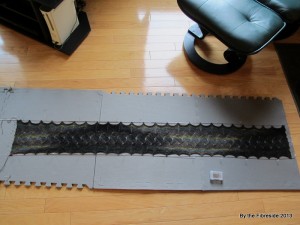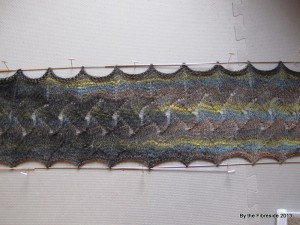I love doing swaps. I can’t do them too often, but I love participating when I can. So when this season’s swap in one of my Ravelry groups came up, and it was a dragon theme, well, I just had to do it. Me and dragons go way back. They were one of the things I drew most often back when I was much younger and drew a little bit. My bookshelves had their fair share of dragons on them, books like Jeremy Thatcher, Dragon Hatcher and Heart’s Blood and Dragon Riders of Pern (naturally). Dragons figured in my scribblings, and they fired up my imagination. There’s just something about dragons, you know?
My swap partner is partial to deeper, earthier colours and non-fitted garments, so a scarf seemed an appropriate project to include in her box. I settled on the Dragon’s Eye Scarf by Jan Henley, and after an aborted attempt at using handspun, cast on with Lang Jawoll Magic sock yarn in the descriptive colourway 84.0026. Basically, it’s blue, yellow, gray, and brown interspersed with black in short colour repeats.
I added one scale section of 26 stitches, and realized soon enough that doing so changed the number of decreases I needed for the scroll section (Whew! That would have been ugly if I hadn’t), but the pattern itself is written only, and since I learned to use charts four years ago, written instructions and me just don’t get along. After the first two pattern rows, I gave up and charted it out on graph paper instead. That was when I had the first inkling that something might not be right. The pattern includes two stitch patterns, a scale pattern to start, a scroll pattern in the middle, and then the scale pattern again, but reversed. The pattern said to do rows 12-1, and then a garter border, and bind off. I didn’t even have to start charting it to know that wasn’t going to look right. So when I sketched out the chart, I reversed the directions of all the decreases, which makes for a pretty looking chart that mirrors the other side.
At this point, I merrily knit along (dabbling with beads but deciding not to), until I got to the end of the scroll pattern, and then started to knit the reversed scales. I got part way through the second pattern row when I realized things still weren’t lining up. Something was wrong.
Now, even six months ago, this might have been the end of it. I would have thrown my hands up in defeat. ‘The pattern isn’t working!’ I might have cried. ‘Maybe I should knit the scale pattern as rows 1-12 instead, because I know that works!’ But that was then, and this is now. And now? I stopped knitting on the scarf, and swatched.

First, as a baseline, I knit the scale pattern as it is in the pattern, rows 1-12. Next, I knit the reversed scale pattern as it is written in the pattern, rows 12-1. Definitely not right. Just a blob of stockinette with some pretty poor shaping, but no defined scale pattern as there is in the baseline. Third up, I knit the reversed scale pattern with the direction of the decreases reversed, so rows 12-1 with k2tog changed into ssk and vice versa. This was how I’d charted it. It’s a little better – cleaner – but still no scales to be seen. I was halfway through that incarnation when I realized what I had to do. Instead of reversing the decreases, I had to reverse everything – turn increases into decreases, and decreases into increases. That yielded the fourth stitch pattern, closest to the needle, which isn’t quite the same as the original, but is close enough. There are defined scales in this version, and if they are a touch smaller or larger than the original, it’s because at that point, I couldn’t get my head around doing a double-increase and still have it lean left and right without having a stitch in the middle. It has a scale pattern, it’s reversed from the original stitch pattern, and it’s a sight better than the two in the middle, so I called it a win. I pulled back the two-and-a-bit rows I’d done, and knit the rest of the scarf.

When did that switch flip for me? When did I become the sort of knitter for whom patterns (at least for scarves, please don’t get me started on sweaters) are just a suggestion? Have I read too much Elizabeth Zimmerman? Have I just knit enough that I can see what the stitches are doing?

Is it a short slippery slope from here to the point where I design my own patterns? Is there enough artistry hiding in my brain to do that?

At the very least, there’s enough understanding of knit construction, or at least stitch pattern construction, for me to reverse-engineer the look I wanted, and that the designer was going for. Yes, I could have just knit rows 1-12 as written and created scales on the opposite side, going in the same direction as the first scales, and it might have looked just fine. But this?

This is what I wanted. And I made it happen.
Tomorrow (hopefully), a bit more about dragons, this time in crochet!
Because you might ask, I’ve added my modifications (written instructions) to my project page on Ravelry, where hopefully they will be useful to someone else who does the scarf. If you find it useful, click my ‘helpful’ button so people know!
